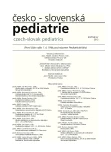Thymidin kinase – suitable marker for diagnostics and follow up in childhood leukemia
Authors:
T. Votava 1; Z. Černá 1; L. Šašek 1; L. Doležalová 1; J. Kobr 1; O. Topolčan 2
Authors‘ workplace:
Dětská klinika, FN Plzeň a Univerzita Karlova v Praze, Lékařská fakulta v Plzni, přednosta doc. MUDr. J. Kobr, Ph. D., Oddělení nukleární medicíny Bory, FN Plzeň a Univerzita Karlova v Praze, Lékařská fakulta v Plzni , primář MUDr. D. Slípková
1
Published in:
Čes-slov Pediat 2012; 67 (1): 23.
Category:
Original Papers
Overview
Background:
Diagnosis of leukemia may be complicated due to the polyvalent symptoms in childhood. In this study, our goal was to determine the potential for early diagnosis of leukemia or relapse using the proliferation marker thymidine kinase 1 (TK1).
Methods:
In the group of 58 children diagnosed with leukemia, we monitored levels of TK1 at the time of diagnosis, during and after therapy using radioenzymatic assay. Control group included 109 children with benign diseases displaying clinical symptoms similar to leukemia.
Results:
We demonstrated the difference in the levels of TK1 at the diagnosis of leukemia compared to patients with other benign diseases (p<0.0001). We also observed that after completing treatment of leukemia, each patient achieved certain basal level of TK1, and the future increase above this basal level (after exclusion of viral infection and hepatopathy) was significant for prediction of a relapse, which often followed 3 to 9 months after the elevation of TK1 (p<0.03).
Conclusions:
Our study shows that TK1 is a suitable proliferation marker for diagnostics and follow up in pediatric patients with leukemia.
Key words:
thymidin kinase, childhood leukemia, diagnostic marker
Sources
LITERATURA
1. Nekulová M, Šimíčková M, Valík D. Nádorové markery a epigenetické faktory. Klin Biochem Metab 2006; 14: 152–156.
2. Ahmed SF, Farqueuharson C. The effect of GH and IGF1 on linear growth and skeletal development and their modulation by SOCS proteins. J End 2010; 206: 249–259.
3. Sýkora J, Pomahačová R, Stožický F, et al. Hladiny inzulinu podobného růstového faktoru-1 (IGF-1) v séru zdravých dětí do 2 let věku. Čes-slov Pediat 2003; 8: 497–499.
4. Ohrvik A, Lindh M, Einarsson R, et al. Sensitive nonradiometric method for determining thymidine kinase 1 activity. Clin Chem 2004; 50: 1597–1606.
5. Welin M, Kosinska U, Mikkelsen NE, et al. Structures of thymidine kinase 1 of human and mycoplasmic origin. Proc Natl Acad Sci U.S.A. 2004; 101: 17970–17975.
6. Fujiwara H, Arima N, Ohtsubo H, et al. Clinical significance of serum neuron-specific enolase in patients with adult T-cell leukemia. Am J Hematol 2002; 71: 80–84.
7. O’Neil KL, Zhang F, Li H, Fuja DG, Murray BK. Thymidine kinase 1 a prognostic and diagnostic indicator in ALL and AML patients. Leukemia 2007; 21: 560–563.
8. Sadamori N, Ichiba M, Mine M, Hakariya S, Hayashibara T, et al. Clinical significance of serum thymidine kinase in adult T-cell leukaemia and acute myeloid leukaemia. Br J Haematol 1995; 90: 100–105.
9. Starý J. Padesát let úspěšné léčby akutní lymfoblastické leukémie. Čes-slov Pediat 2007; 9: 540–545.
10. Topolcan O, Holubec L Jr. The role of thymidine kinase in cancer diseases. Expert Opin Med Diagn 2008; 2: 129–141.
11. Topolcan O, Holubec L, Kausitz J, et al. Thymidine kinase monitoring importance in the routine clinical practice. Anticancer Res 2004; 24: 3655–3656.
12. Topolcan O, Holubec L Jr, Svobodova S, et al. The diagnostic and prognostic significance of thymidinkinase in tumor diseases. J Clin Ligand Assay 2007; 29: 190–193
Labels
Neonatology Paediatrics General practitioner for children and adolescentsArticle was published in
Czech-Slovak Pediatrics

2012 Issue 1
Most read in this issue
- When to search for inhereted thrombophilia risk factors in children?
- Influenced pain by children dental treatment
- The effect of thumb sucking on splanchocraniums development in childhood
- Thymidin kinase – suitable marker for diagnostics and follow up in childhood leukemia
